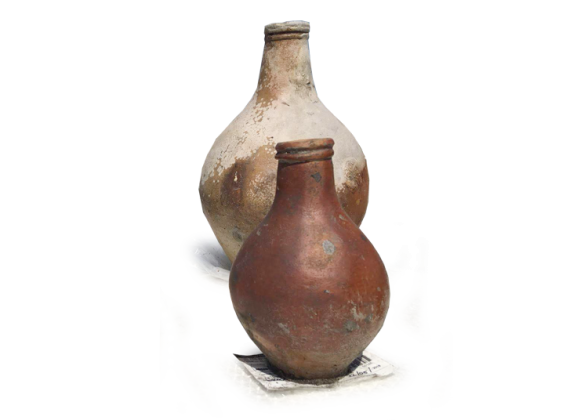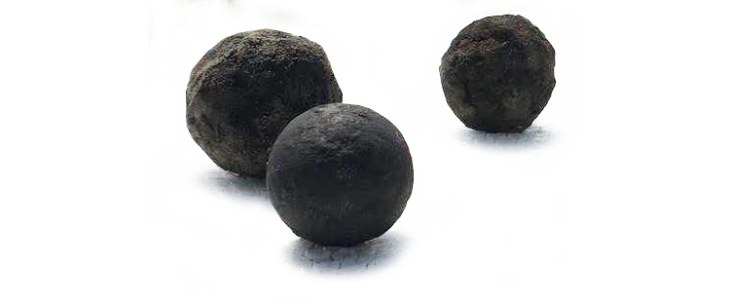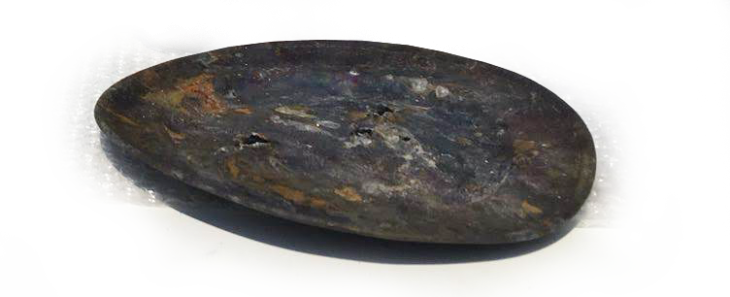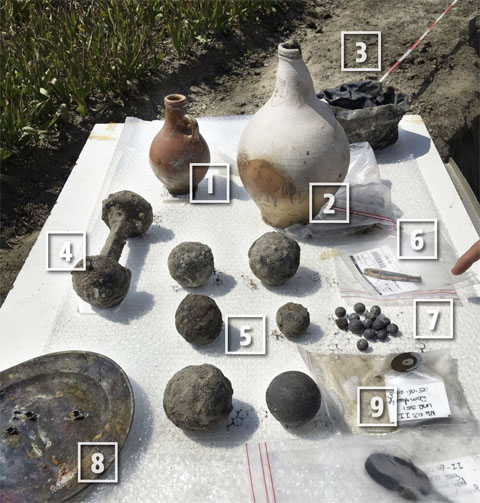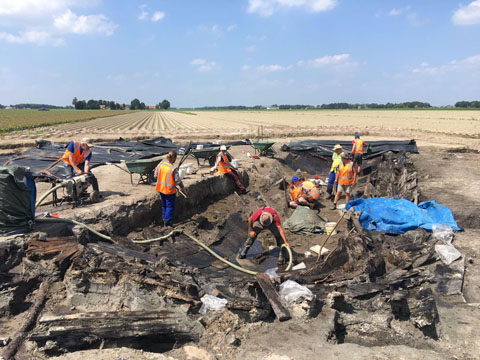
Digging for ships
Rescuing wrecked shipwrecks
There are potentially five hundred ships hidden around the Flevopolder. They were all lost between the late Middle Ages and the impoldering that occurred in 1940. The English three-master, a merchant ship from the eighteenth century discovered in Rutten in 2016, is a wonderful specimen. Yftinus van Popta, PhD candidate of archaeology at the RUG, began excavating the 35-metre long ship with his student team on Wednesday.
Farmer Dijkstra discovered the ship when he was ploughing his potato field. His tractor suddenly made a funny noise. There was a piece of wood stuck in it that turned out to be part of the three-master.
Van Popta’s team only just started digging, but they’ve already found their first prize: a pewter dish. ‘It just needs a little polishing and it’ll look good as new’, he says. Archaeologists are mainly interested in the objects’ scientific value; Van Popta probably won’t find gold on this ship, which mainly transported wine barrels. He probably won’t find gold on any of the other ships in the polder, either. But that’s okay. A full set of dinnerware, a nice dish, or a handful of coins is just as valuable to him.
A thousand ships
Before Van Popta was working on this excavation, he spent every day on his PhD project. Among other things, he mapped the ships still buried underground in Flevoland and the IJsselmeer (the former Zuider Zee). In Flevoland, there are at least 450, ten of which are as large as the English three-master – which, incidentally, was not on his map.
What was still in good condition in the fifties may now be a sad pile of wood
‘There are also ships that have never been recorded’, he explains. ‘In Flevoland alone there might be more than five hundred ships.’ He calculated that there could be approximately four hundred ships in both the Markermeer and the IJsselmeer. ‘It’s hard to put an exact number to it, but there are at least a thousand, if not more.’
Dangerous Zuider Zee
The Zuider Zee was an extremely dangerous shipping route. Only experienced captains dared to sail it. It was extremely shallow and littered with sandbanks. There were designated shipping routes, but skippers who deviated from them were likely to crash on the rocks.
On top of that, a hard northwesterly wind always blew across the Zuider Zee, creating massive waves. So it’s no wonder that in the first decade of the twentieth century, more than a hundred ships were wrecked there.
The ships date back to a period between the late Middle Ages – the thirteenth century – and the impoldering in 1940. They are mainly small cargo ships and fishing boats. In Flevoland, about 220 ships have been excavated, but they haven’t always been documented properly. Van Popta: ‘Sometimes all they wrote was: “We excavated a ship that probably dates back to the eighteenth century.” This is a shame, because we really could have used the information they gathered back then.’
00 start
Vondsten – kleine kruik
This is a Bartmann jug. These jugs were made all over Europe between the fifteenth and eighteenth centuries, especially in Germany. They were available in many sizes and could be used for many different things.
vondsten – Grote kruik
This is a Bartmann jug. These jugs were made all over Europe between the fifteenth and eighteenth centuries, especially in Germany. They were available in many sizes and could be used for many different things.
vondsten – pannetje
This is a pewter saucepan. Interestingly enough, the object is full of dents which were probably made by bullets. How did they get there? Perhaps someone used the pan as a shield in the heat of battle. But it’s also possible that bored crewmen used the pan for target practice.
vondsten – halter
It might look like a dumbbell, but this object was not used by eighteenth-century #fitgirls. It’s catapult ammunition, to be used in a canon. When shot, the projectile would fly, spinning, towards its target. It did more damage than ‘normal’ cannon balls.
vondsten – 6 kogels
These six cannon balls were also found in the wreck. They’re made of lead, which means they’re very heavy.
vondsten – notenkraker
This device was an eighteenth-century two-in-one machine. The ‘arms’ were used to crack nuts, while the round end could stuff a pipe with tobacco.
vondsten – musketkogels
Number five’s younger brothers. These lead pellets were fired by the predecessor of the modern gun, the musket. This ship apparently kept quite a lot of ammunition around; Van Popta and his students keep finding these little pellets everywhere.
vondsten – bord
A pewter plate. This, too, is pocked with bullet holes. The plate has a London stamp – a clue that the ship is English.
vondsten – damstenen
Hardly visible. But in this plastic bag are draughts pieces, to kill the time.
mobiele versie
1 and 2: These are Bartmann jugs. These jugs were made all over Europe between the fifteenth and eighteenth centuries, especially in Germany. They were available in many sizes and could be used for many different things.
3: This is a pewter saucepan. Interestingly enough, the object is full of dents which were probably made by bullets. How did they get there? Perhaps someone used the pan as a shield in the heat of battle. But it’s also possible that bored crewmen used the pan for target practice.
4: It might look like a dumbbell, but this object was not used by eighteenth-century #fitgirls. It’s catapult ammunition, to be used in a canon. When shot, the projectile would fly, spinning, towards its target. It did more damage than ‘normal’ cannon balls. Speaking of which…
5: … these six cannon balls were also found in the wreck. They’re made of lead, which means they’re very heavy.
6: This device was an eighteenth-century two-in-one machine. The ‘arms’ were used to crack nuts, while the round end could stuff a pipe with tobacco.
7: Number five’s younger brothers. These lead pellets were fired by the predecessor of the modern gun, the musket. This ship apparently kept quite a lot of ammunition around; Van Popta and his students keep finding these little pellets everywhere.
8: A pewter plate. This, too, is pocked with bullet holes. The plate has a London stamp – a clue that the ship is English.
9: Draughts pieces, to kill the time.
‘I’m hoping for a body’
Van Popta has a rough idea where the ships are, but no idea what’s in them. ‘I’m hoping for a body’, he jokes. ‘A body would have a lot of information. We’d be able to do DNA research and carbon dating.’
Unfortunately, bodies are rarely found in the shipwrecks. ‘Even the smallest ships were outfitted with small rowing boats, to allow crewmen to flee as the ship was sinking’, Van Popta explains. ‘If there was no rowing boat, they would climb the mast. The ship would sink, but because the Zuider Zee was so shallow, the mast would remain above sea level. By clinging to it, they could be rescued.’
Also, most bodies eventually float to the surface, unless they are somehow trapped. Van Popta has only found a body once. ‘It was a captain stuck in the fore-cabin. When he tried to escape, a large metal object pinned down his leg. That’s how we found him.’
Sad pile of wood
Historical value isn’t the only reason to excavate these ships. The quality of the wrecks is declining rapidly. ‘What was still in good condition in fifties may now be a sad pile of wood’, says Van Popta.
The ships’ condition was preserved so long as they stayed underwater and away from oxygen. But when the area was impoldered, the ground dried up – which also dried up the wood. ‘In that sense, the ships get wrecked twice’, says Van Popta. ‘Once at sea, and once in the ground.’
We call ourselves a maritime nation, but we don’t even have money for a maritime specialisation
‘The first barrel from this ship, which was excavated in 2016, was in good condition’, he says. ‘We recently found another barrel, but the hoops were completely broken and the wood was of terrible quality.’ He feels that excavating the ships in shallow ground should be a priority. ‘Small ships can tell us a lot about the maritime history of the Netherlands, for instance about domestic contacts.’
New life
Excavations are expensive. Digs can take months, after which all the materials have to be transported and analysed. This particular excavation is an emergency study, because the ship is in shallow ground and in danger of decaying. The municipality and the RUG are funding the project together. ‘I’d love it if the other wrecks were explored, at least to assesses the quality of the wood’, says Van Popta. ‘We might be able to strike a deal with the Noordoostpolder.’
Van Popta would like to breathe new life into the field of maritime archaeology by reinstating the master programme, which was offered by the RUG until 2014, when it was scrapped. Van Popta: ‘We call ourselves a maritime nation, but we don’t even have money for a maritime specialisation. People have to go to England for that. That’s messed up.’
Exploring the few hundred hidden ships in the Flevopolder, and a maritime specialisation for Dutch archaeology students? Van Popta would do anything for that.
He and his students will be working on the dig in Rutten until August, and then he’ll start cataloguing the pieces for further study. There is another excavation planned. ‘I want to finish this dig first, but there’s a list of excavations we could work on if we could get some sort of collaboration going. If not, I’ll continue my PhD research. That kind of fell by the wayside.’


